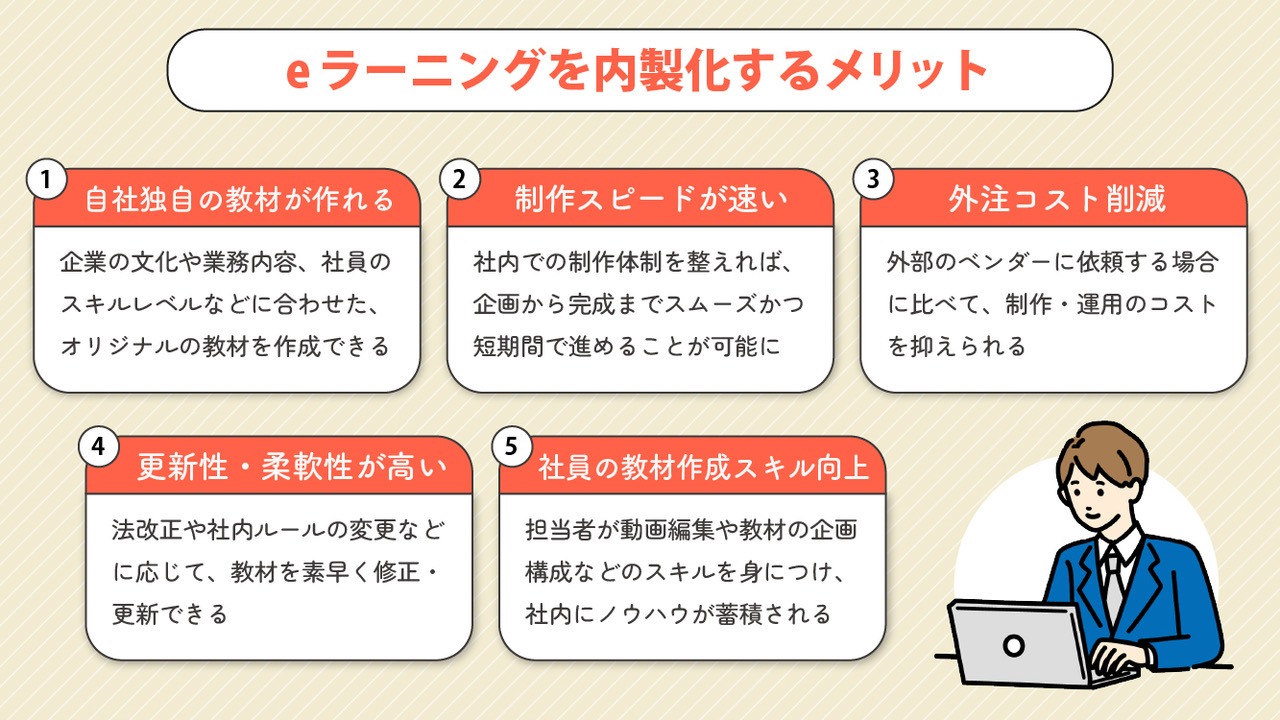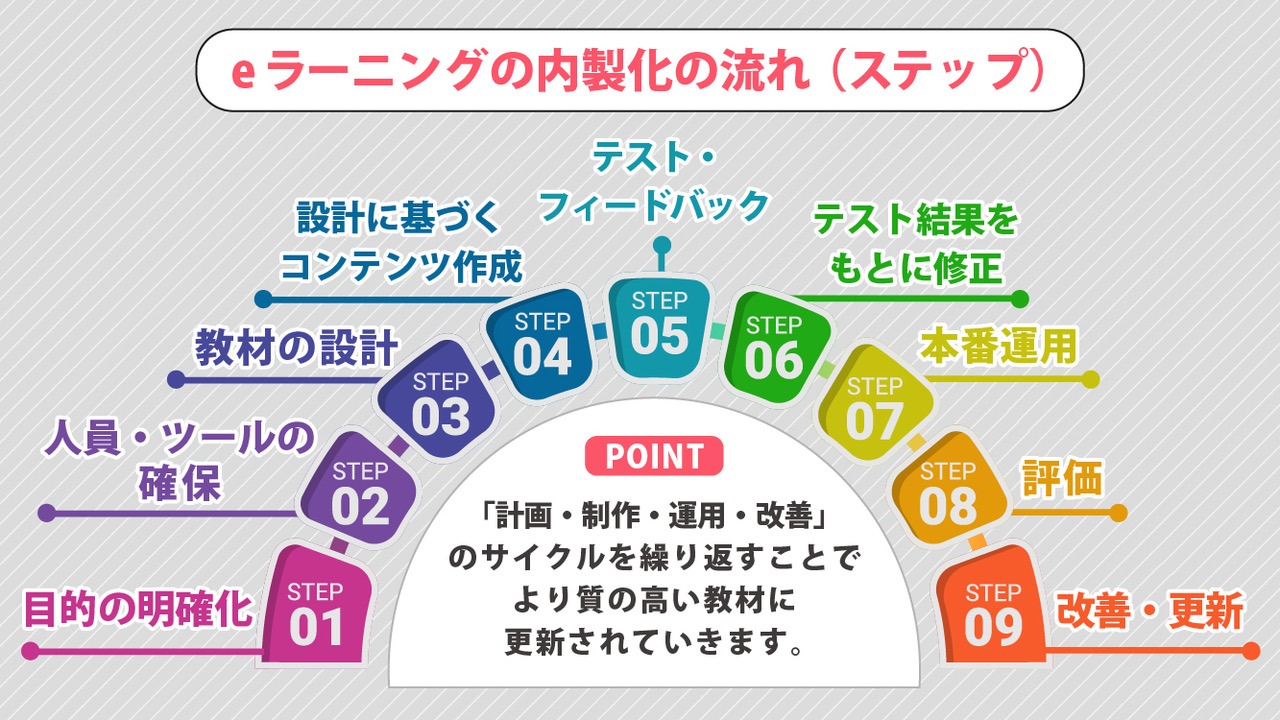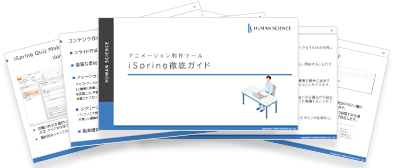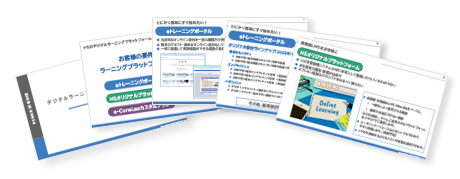2025.07.10
What are the benefits of in-house e-learning development? Explanation of the process and points to note

Currently, many companies are adopting e-learning as a method for training and education, but there is growing attention on the trend of "in-house production" where content creation and management are handled internally rather than outsourced to external vendors.
This article clearly explains the benefits of in-house e-learning production, the process leading up to implementation, and key points to be aware of. If you are considering in-house production or planning to introduce e-learning, please use this as a reference.
1. What is in-house production of e-learning?

First, let's grasp the basics of e-learning and then understand the overview of in-house production.
<e-Learning>
E-learning is an educational method that allows you to learn at your own pace using electronic devices such as computers, smartphones, and tablets, regardless of location or time. In companies, it is utilized in a wide range of areas including employee training, skill development, and compliance education. It offers comprehensive features such as progress management, tests, and surveys, enabling efficient and effective education.
<e-Learning In-house Production>
When introducing e-learning, it is necessary to have teaching materials that correspond to the learning content. Generally, there are methods such as using commercially available materials or requesting a specialized production company, but there is also the method of producing and managing materials in-house. This is called "in-house production."
To produce materials in-house, mainly e-learning authoring tools are utilized.
The greatest advantage of in-house production is the ability to create original materials directly linked to your company's situation and operations. While there are benefits such as this flexibility and cost advantages, there are also challenges like securing production skills and resources.
The next chapter provides a detailed explanation of the specific benefits gained through in-house production.
>What is e-learning? Explanation from purpose, history, advantages and disadvantages, usage, to key points for implementation!
>What are e-learning content creation tools? Strong allies for content creation! Introducing 8 recommended tools and their benefits
2. Benefits of In-House e-Learning Development
For companies that want to achieve high-quality training tailored to their own challenges while keeping costs down, "in-house production" is a very effective option. Here, we will organize the benefits of such in-house production.
〈Merit 1〉Training with educational content tailored to your company's unique needs and circumstances is possible
The greatest advantage of in-house production is the ability to create original training materials tailored to the company's culture, business operations, and employees' skill levels. Existing materials tend to be generic, but with original materials, you can train exclusively on your company's unique know-how and rules.
〈Merit 2〉Fast Production Speed
If you establish a production system within the company, it is possible to smoothly and quickly proceed from planning to completion of the teaching materials.
〈Merit.3〉Reduction of Outsourcing Costs
Compared to outsourcing to external vendors, production and operational costs can be reduced. In the long term, companies that require continuous educational material development will find in-house production to be more cost-effective.
〈Merit 4〉High Updatability and Flexibility
You can quickly revise and update teaching materials in response to legal amendments and changes in internal rules. Since there is no need to communicate or coordinate with external contractors each time changes occur, it eliminates hassle and time lags, making it easier to maintain the currency of educational content.
〈Merit.5〉 Improvement of employees' training material creation skills
By bringing production in-house, staff members acquire skills such as video editing, narration, and planning and structuring educational materials, allowing know-how to accumulate within the company. As a result, the development of educational materials becomes smoother with each iteration.
In-house production of e-learning is an excellent method that allows you to create optimal teaching materials quickly and at low cost. Companies that want to balance quality and flexibility in education are recommended to consider in-house production as one of their options.

3. Process of In-house Development of e-Learning (Steps)
To successfully internalize e-learning production, it is important to understand the proper procedures for creating teaching materials and proceed systematically. This chapter introduces the general steps for internalization.

〈Step.1〉Clarification of Purpose
First, let's establish clear objectives such as "What is the purpose of the training?", "Who is the target audience?", and "What skills or knowledge do we want them to acquire?". By setting goals, the training materials will have consistency in content, enabling the design of training that aims for high learning effectiveness.
〈Step.2〉Securing Personnel and Tools
Secure members involved in teaching material production and operation, and establish necessary systems such as LMS (Learning Management System) and authoring tools. If you have personnel with specialized knowledge, you can proceed with in-house production more smoothly.
〈Step.3〉Design of Teaching Materials
We design the structure, scenarios, and learning steps of the teaching materials. At this stage, decide on the formats and presentation methods to use, such as "videos," "quizzes," and "slides." The ideal structure keeps learners engaged and helps deepen their understanding.
〈Step.4〉Content Creation Based on Design
Based on the blueprint from Step 3, we begin creating the teaching materials. We concretize the content by preparing narration scripts, slide materials, video shooting, editing, and more.
〈Step.5〉Test & Feedback
First, conduct a trial run of the completed teaching materials with a limited target audience. Then, check the learners' reactions and level of understanding, gather their opinions, and identify areas for improvement. The feedback at this stage is key to creating high-quality teaching materials.
〈Step.6〉Corrections Based on Test Results
We reflect test results and feedback from learners to revise and restructure the content. These detailed adjustments greatly enhance the quality of the teaching materials.
〈Step.7〉Production Operation
We will officially release and operate the teaching materials. Let's smoothly proceed with the operation by utilizing the functions of the LMS.
〈Step.8〉Evaluation
Evaluate the extent of the learning effect achieved against the set goals. It is important to verify the learner's level of understanding from a "multifaceted perspective," including tests, surveys, and the subsequent impact on work.
〈Step.9〉Improvement and Update
Based on the evaluation results of Step 8, regularly review the content, structure, and operation methods of the teaching materials. Prompt and flexible updates support the continuous learning effectiveness of e-learning.
E-learning materials are not finished once created; by repeating the cycle of planning, production, operation, and improvement, they are updated to higher quality. Keep the above steps in mind and aim to successfully internalize the process.
4. Points to Note When Bringing e-Learning In-House

We explain the key points to consider when bringing e-learning development in-house. Let's be aware of common pitfalls and their countermeasures.
〈1〉If you proceed with in-house production haphazardly, it will not go well
If you start creating teaching materials without clearly defining the learning objectives and target audience, the direction tends to become unclear, resulting in materials that are often lacking in substance.
▶Solution for <1>
As mentioned in the previous chapter "<Step.1> Clarification of Purpose", the key is to clearly define the purpose and target, and proceed step-by-step according to the steps described above.
〈2〉Lack of Expertise and Skills is a Challenge
Video editing and instructional design require a certain level of expertise for in-house e-learning development. Without such skills, the person in charge risks producing low-quality materials.
▶ Solution for <2>
Supplement the necessary skills by receiving vendor support or attending training for the person in charge.
〈3〉Securing Human and Time Resources
Creating teaching materials alongside other tasks is more burdensome than one might imagine. Additionally, if there is a shortage of human resources, production may be prolonged, and the quality of the materials may decline.
▶ Solution for <3>
When adjusting the production system, plan to secure dedicated personnel and time. It is also important to incorporate measures to reduce the burden, such as dividing tasks and utilizing creation tools like iSpring Suite AI.
In-house production of e-learning can lead to troubles due to lack of preparation and planning. By focusing on appropriate processes, skill supplementation, and securing resources, you can surely create high-quality materials.
5. Summary

In-house production of e-learning enables education optimized for your company's needs and also offers benefits in terms of cost and operation. Of course, creating materials requires effort, but by utilizing authoring tools like iSpring Suite AI, you can intuitively create materials with the feel of operating PowerPoint, supporting smooth in-house production.
That said, in-house production requires specialized knowledge and the establishment of a proper system. For those who "don't know where to start," consulting a vendor that supports the introduction of e-learning is one option.
Since starting our services in 2000, Human Science has produced approximately 3,000 e-learning materials. We are also an authorized reseller of iSpring products and provide extensive support related to e-learning production, including proposals for iSpring products and hosting usage seminars. If you are looking to improve the quality of your in-house training, please feel free to consult with Human Science.
For more details on services related to iSpring products, please check the following page.
> Create rich e-learning materials with the familiar PowerPoint you are used to - iSpring Implementation Support
Understand the Features and Usage of iSpring Suite / iSpring Suite AI!Comprehensive iSpring Guide

This section introduces the overview and usage of the animation teaching material production tool "iSpring."
This book provides a complete understanding of iSpring. You will also have an image of the teaching material production after implementation.
【Contents】
- What is iSpring Suite / iSpring Suite AI
- How to create teaching materials using iSpring Suite / iSpring Suite AI
- Overview and utilization of iSpring Suite AI
- Features of iSpring Suite AI
- Specific Usage of iSpring Suite AI
- iSpring Suite AI Certified Resellers
- Introduction to Human Science














